The Pursuit of Property: The Afterlife of an Armenian Charitable Complex in Istanbul
By Naomi CohenJune 18, 2022
:quality(75)/https%3A%2F%2Fdev.lareviewofbooks.org%2Fwp-content%2Fuploads%2F2022%2F06%2Farmenianhospital.png)
WHEN TOURISTS take the shuttle out of the Istanbul airport, they are likely to notice a deep crater across from the last stop, overlooked by a bunch of hollowed-out pastel houses. This mess was supposed to be a shopping mall, convention center, theater, hotel, and more — an “international fun system,” in the words of Selim Dalaman, the architect behind the project.
People would come here to forget, buy, laugh, swim, dine, dance, and sleep. Dalaman was used to larger-than-life projects, but this one, he said, was the biggest he could ever hope to build in such a central spot, in a city of 15 million, on “virgin” land.
Yet as the story goes in most cities, especially ones several millennia old, the land wasn’t virgin. For 175 years, it had held the Armenian Catholic Surp Agop Hospital and its appendages, including a retirement home, a mental asylum, and low-rent housing. The foundation that ran them helped the congregation survive some of the darkest days in the region’s history: it gave free schooling to children orphaned by the 1915 Armenian Genocide and free care to members crippled by discriminatory taxes in 1942. It also pooled wealth in the community to keep it there, even after entire families moved continents.
However far or high the city stretched, and however tense the days for Armenians in Turkey, the buildings stayed put, a reminder that they were inked into the skin of Istanbul. But on paper, the property was itself orphaned. With nothing but a sultan’s decree and a 1936 record to its name, it had no owners, at least in the modern legal sense. This left it under the yoke of the Turkish state — until the state made amends, and the hospital plot vanished.
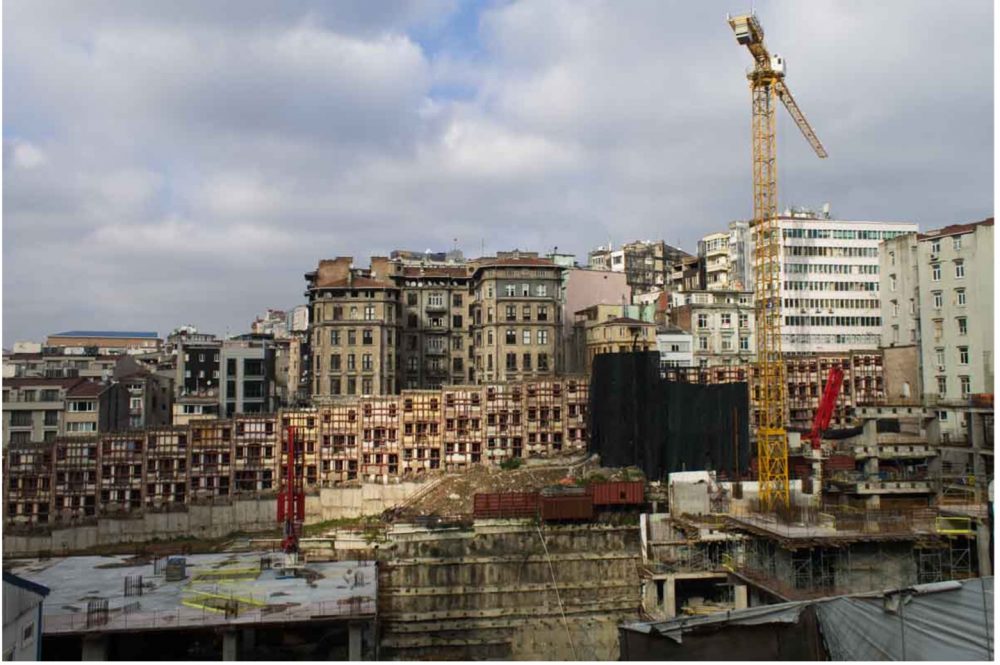
The Surp Agop Hospital Foundation is “slowly wasting away and under threat of disappearing,” wrote its board president in 1957 in the short-lived Surp Agop Hospital Nonpolitical Monthly Magazine. The truth was that, back then, it was not. Costs were up and donations were down, but the buildings it ran and inherited from members without family were gaining value.
Conrad Hilton built his first international hotel just across from the hospital, on top of an Armenian cemetery, which the city had seized and resold for cheap. To keep up, the Surp Agop board spruced up its three dozen shopfronts and cleared its vegetable patch and a unit of social housing to build the Şan Theatre, a music hall the likes of Radio City.
Then, in 1987, it caught fire. Smoke curled into the retirement home above the hospital, but only the theater burned.
“It wasn’t that old of a building,” said a congregation member, “but it became history.” The theater wasn’t just a piece of real estate; it had placed the foundation at the frontier of Istanbul nightlife, with its classical concerts, spaghetti Westerns, musicals, and air conditioning. The board wanted no less of the building that would replace it: a pair of American consultants had told them they were underselling their worth, and that was just in financial terms.
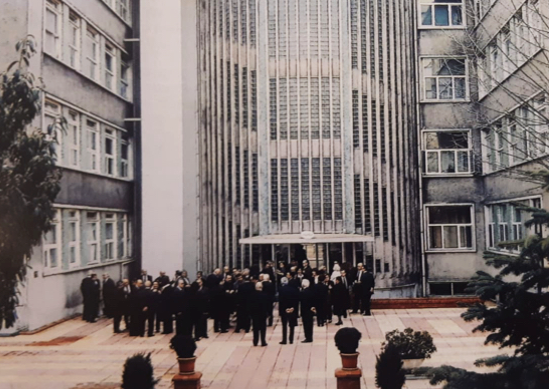
The timing of the fire was lucky. Turkey had its first prime minister who didn’t make life hard for non-Muslim foundations. Turgut Özal was also a World Bank veteran and did all the things a good liberalizer does. He privatized industry and opened Turkey to free trade. He also looked into returning large plots of land to diasporic Armenians, after a cost-benefit analysis told him they had high sums to invest.
Özal’s plan was too radical for its time, but the Surp Agop Foundation’s project wasn’t. An industrial conglomerate that was friendly with Özal signed with the board to build an entertainment complex where the Şan Theatre had been. They swiftly got permission — but when Özal died two years later, ultranationalists killed the project.
The foundation waited for the next liberalizer to help them resurrect it. In 1999, Board President Greguar Akan met Recep Tayyip Erdoğan, then former mayor of Istanbul, at a cocktail party. Akan told Erdoğan and his colleague Abdullah Gül about the entertainment complex.
“You’ll do it, no problem,” he remembered them telling him. “You’ll only have issues if there’s a historical relic.”
“There isn’t.”
“Then you’ll do it.”
When Erdoğan became prime minister, he appointed Gül as foreign minister to push forward talks to join the European Union. The EU prioritized property rights for non-Muslims. In 2008, Gül, by then president, opened a way for Armenian and other non-Muslim charitable foundations to claim their right to thousands of their unregistered and confiscated properties. It was an uneasy peace. Most applications were rejected. Some modest properties were pried from government hands after years of trial. The easiest returns went straight to construction contractors, driving their owners to their own destruction.
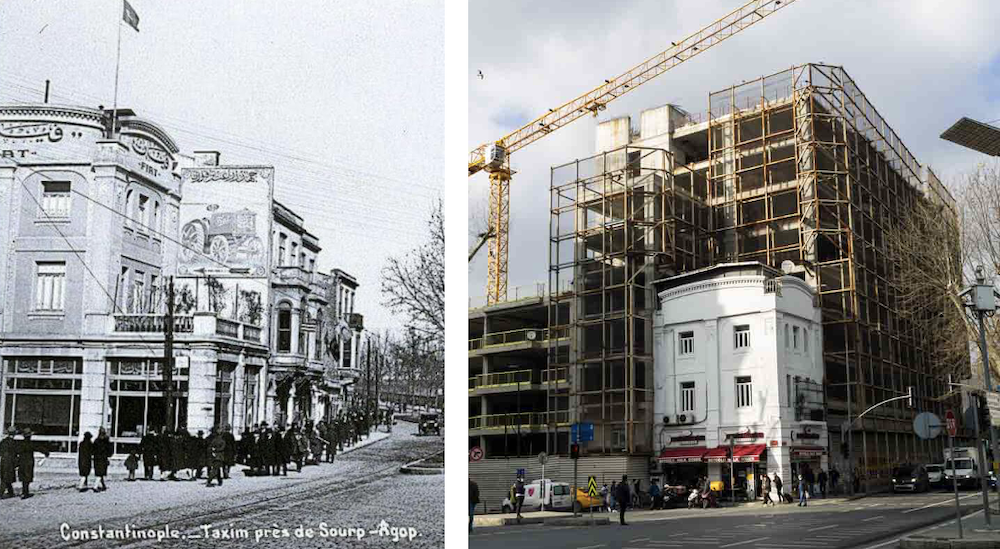
On the corner of the Surp Agop property, across from Taksim’s Gezi Park, sits a döner restaurant. In late 2013, after the foundation scored its title deed and before it sent the first bulldozers, the restaurant’s manager wanted to move the women’s toilet from the third floor to the second. The Istanbul Chamber of Architects told him that his building was a historical relic. He wondered why his was the only protected building on the block.
“If I scream, three people will hear my voice,” he said, “but if that hotel’s owner screams” — he pointed across the street — “a thousand people will hear him. It’s a different tune.”
A heavyweight joined the foundation’s redevelopment team around the same period because Dalaman was stuck. His company, Vizzion Europe, had contacts in Brussels who could finance the project, but they needed a title deed. He had men in Ankara who could expedite the title deed, but they were rivals with city officials who approved the zoning. Then Dursun Özbek, a hotel magnate, stepped in. He brought in big names, like a Marriott hotel operator, and made the plan more attractive and “green” by carving out an interior plaza dressed with hanging wisteria and bistro tables.
The project was called Şan City after the theater, but its redesign wasn’t done in its spirit. It was done out of fear. Özbek came on board just as protests had shaken Turkey’s construction establishment. Thousands of people occupied Gezi Park in summer 2013, hugging trees and pitching tents to stop its redevelopment and all speculative projects that preyed on the old heart of Istanbul. During Erdoğan’s first decade in power, every other corner of the city was shuttered with the logos of builders turning shacks into boutique hotels, fields into forests of high-rise condos. As the protests swelled, so did their demands: resign, nationalize, make peace.
That summer, the hospital reeked of tear gas. After the tear gas came silence. Erdoğan blamed foreigners for meddling and threw opponents in jail, accusing them of plotting the failed 2016 coup. European investors didn’t like this, and Asian and Gulf money wasn’t enough of a stopgap. The Turkish lira tumbled, and construction yards were put to sleep. Dalaman was hired to build a nine-story multipurpose mosque that now crowns Taksim Square, but the Şan City project stalled. Özbek and other backers dropped out. The site fell apart: a scaffolding collapsed. A construction container went up in flames.
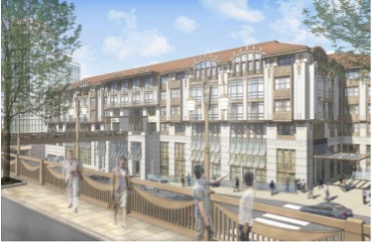
Levon Zekiyan, archbishop of the Armenian Catholic Church of Istanbul, had seen it all coming. There was no guarantee that the construction hype would continue, he said. “It’s written in the Bible: seven years of plenty, then seven years of famine.” Joseph said to hoard wheat.
The foundation board unanimously wanted to build an entertainment complex — with meager donations and no state support, it needed the profits to afford the latest medical technology. But they split on whether they should restore the hospital or scrap it for a new one. The second plan won out, tying the fate of the hospital and its side services to the fate of the project. Only a fraction of the Surp Agop doctors stayed on, squeezing into a polyclinic in an apartment on the other end of the döner restaurant, the only other building left standing.
The Surp Agop board also gambled on the contract’s duration. It would not pay to erect Şan City, but it deferred its land to Vizzion Europe for 44 years.
“Considering the population of the Catholic community today, the situation in 44 years is beyond imaginable,” stated a critique that was published in Agos, an Armenian weekly. Turkey no longer runs a census on religion, but Armenian Catholics say they number around 2,500 — less than half the size of when they founded the Surp Agop hospital in 1831. Back then, all non-Muslims made up about half of Istanbul’s population; today, they represent roughly one percent.
Who counts as a member is also up for debate. Selin Kalkan was born after the theater fire to an Armenian Catholic mother and a Turkish Muslim father. She didn’t go to church and, as a child of mixed marriage, was barred from Armenian school. Her only link to the congregation, then, was her home in the row houses whose rent the Surp Agop Foundation kept low. Eviction broke that link for good. For the other 120 renters who didn’t have a summerhouse to move into, the eviction also broke their trust.
“I don’t think anyone cares about the foundation anymore,” Kalkan said. The row-house residents were relocated to two apartment blocks a neighborhood away, equipped with televisions, elevators, and other domestic comforts. But nothing is the same: the slopes there hurt their knees, the speakers of the next-door mosque blare straight into their windows, and the only church close by is reserved for funerals.
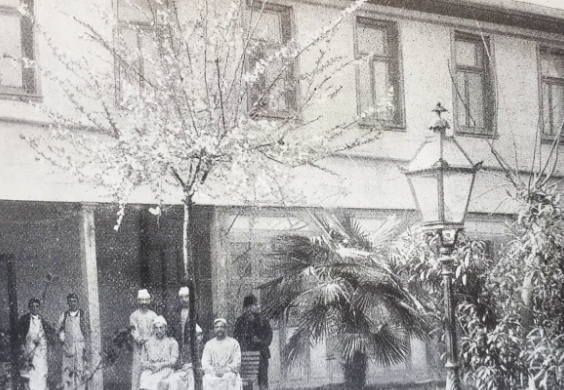
Armenian Catholic pashas and moneylenders built the Surp Agop Hospital in 1831 to sustain life. They later created its charitable foundation, or vakıf, because it was the only way in the Ottoman Empire to keep property in the family and not risk its seizure. The sultan reserved the vakıf legal title for Muslim foundations, since, by definition, they managed endowments to God, but he informally granted his non-Muslim subjects vakıf land to win their favor.
When the Turkish Republic rewrote its property code based on the one used by Anglo-Saxons in the 1930s, it struggled to translate the vakıf title. The new law was secular, but the title was religious. It encouraged accumulation but for charity, not growth. The vakıf properties of non-Muslims became outliers, bullied and tagged as national security risks. When Ankara reversed its stance and adapted the vakıf title to the modern market, it seemed that everyone would win. But in this market, everyone could also lose.
Şan City was scheduled to open in 2018. In 2019, the board wondered if the day would ever come. It sued. Meanwhile, Vizzion Europe’s office in Brussels declared bankruptcy, and the one in Istanbul downgraded from a sultan’s waterfront palace to a dim space above the polyclinic.
On an average day in the Surp Agop lot, two or three workers will fiddle with cranes, like ants in a canyon, passing away the time. Tourists may snap a photo of the site, unaware that many more eyesores like this await them.
Property restitution aims to turn a loss into a gain, to fill a hole with something tangible. It lets the last owners take up where they left off and build something for posterity. Or, in the case of the Armenian hospital plot, it lets an “invisible hand” decide their future for them.
Naomi Cohen is a freelance journalist based in Istanbul. She reported this story with a grant from the Pulitzer Center and continued her research on non-Muslim hospital foundations in Istanbul in collaboration with Gabriel Doyle and Yasemen Cemre Gürbüz. Their multimedia installation and video were exhibited in the show Finding a Cure in Istanbul, which took place in a tunnel under Gezi Park, put on by Karşı Sanat and the Istanbul Metro.
People would come here to forget, buy, laugh, swim, dine, dance, and sleep. Dalaman was used to larger-than-life projects, but this one, he said, was the biggest he could ever hope to build in such a central spot, in a city of 15 million, on “virgin” land.
Yet as the story goes in most cities, especially ones several millennia old, the land wasn’t virgin. For 175 years, it had held the Armenian Catholic Surp Agop Hospital and its appendages, including a retirement home, a mental asylum, and low-rent housing. The foundation that ran them helped the congregation survive some of the darkest days in the region’s history: it gave free schooling to children orphaned by the 1915 Armenian Genocide and free care to members crippled by discriminatory taxes in 1942. It also pooled wealth in the community to keep it there, even after entire families moved continents.
However far or high the city stretched, and however tense the days for Armenians in Turkey, the buildings stayed put, a reminder that they were inked into the skin of Istanbul. But on paper, the property was itself orphaned. With nothing but a sultan’s decree and a 1936 record to its name, it had no owners, at least in the modern legal sense. This left it under the yoke of the Turkish state — until the state made amends, and the hospital plot vanished.

The Surp Agop Hospital Foundation is “slowly wasting away and under threat of disappearing,” wrote its board president in 1957 in the short-lived Surp Agop Hospital Nonpolitical Monthly Magazine. The truth was that, back then, it was not. Costs were up and donations were down, but the buildings it ran and inherited from members without family were gaining value.
Conrad Hilton built his first international hotel just across from the hospital, on top of an Armenian cemetery, which the city had seized and resold for cheap. To keep up, the Surp Agop board spruced up its three dozen shopfronts and cleared its vegetable patch and a unit of social housing to build the Şan Theatre, a music hall the likes of Radio City.
Then, in 1987, it caught fire. Smoke curled into the retirement home above the hospital, but only the theater burned.
“It wasn’t that old of a building,” said a congregation member, “but it became history.” The theater wasn’t just a piece of real estate; it had placed the foundation at the frontier of Istanbul nightlife, with its classical concerts, spaghetti Westerns, musicals, and air conditioning. The board wanted no less of the building that would replace it: a pair of American consultants had told them they were underselling their worth, and that was just in financial terms.

The timing of the fire was lucky. Turkey had its first prime minister who didn’t make life hard for non-Muslim foundations. Turgut Özal was also a World Bank veteran and did all the things a good liberalizer does. He privatized industry and opened Turkey to free trade. He also looked into returning large plots of land to diasporic Armenians, after a cost-benefit analysis told him they had high sums to invest.
Özal’s plan was too radical for its time, but the Surp Agop Foundation’s project wasn’t. An industrial conglomerate that was friendly with Özal signed with the board to build an entertainment complex where the Şan Theatre had been. They swiftly got permission — but when Özal died two years later, ultranationalists killed the project.
The foundation waited for the next liberalizer to help them resurrect it. In 1999, Board President Greguar Akan met Recep Tayyip Erdoğan, then former mayor of Istanbul, at a cocktail party. Akan told Erdoğan and his colleague Abdullah Gül about the entertainment complex.
“You’ll do it, no problem,” he remembered them telling him. “You’ll only have issues if there’s a historical relic.”
“There isn’t.”
“Then you’ll do it.”
When Erdoğan became prime minister, he appointed Gül as foreign minister to push forward talks to join the European Union. The EU prioritized property rights for non-Muslims. In 2008, Gül, by then president, opened a way for Armenian and other non-Muslim charitable foundations to claim their right to thousands of their unregistered and confiscated properties. It was an uneasy peace. Most applications were rejected. Some modest properties were pried from government hands after years of trial. The easiest returns went straight to construction contractors, driving their owners to their own destruction.

On the corner of the Surp Agop property, across from Taksim’s Gezi Park, sits a döner restaurant. In late 2013, after the foundation scored its title deed and before it sent the first bulldozers, the restaurant’s manager wanted to move the women’s toilet from the third floor to the second. The Istanbul Chamber of Architects told him that his building was a historical relic. He wondered why his was the only protected building on the block.
“If I scream, three people will hear my voice,” he said, “but if that hotel’s owner screams” — he pointed across the street — “a thousand people will hear him. It’s a different tune.”
A heavyweight joined the foundation’s redevelopment team around the same period because Dalaman was stuck. His company, Vizzion Europe, had contacts in Brussels who could finance the project, but they needed a title deed. He had men in Ankara who could expedite the title deed, but they were rivals with city officials who approved the zoning. Then Dursun Özbek, a hotel magnate, stepped in. He brought in big names, like a Marriott hotel operator, and made the plan more attractive and “green” by carving out an interior plaza dressed with hanging wisteria and bistro tables.
The project was called Şan City after the theater, but its redesign wasn’t done in its spirit. It was done out of fear. Özbek came on board just as protests had shaken Turkey’s construction establishment. Thousands of people occupied Gezi Park in summer 2013, hugging trees and pitching tents to stop its redevelopment and all speculative projects that preyed on the old heart of Istanbul. During Erdoğan’s first decade in power, every other corner of the city was shuttered with the logos of builders turning shacks into boutique hotels, fields into forests of high-rise condos. As the protests swelled, so did their demands: resign, nationalize, make peace.
That summer, the hospital reeked of tear gas. After the tear gas came silence. Erdoğan blamed foreigners for meddling and threw opponents in jail, accusing them of plotting the failed 2016 coup. European investors didn’t like this, and Asian and Gulf money wasn’t enough of a stopgap. The Turkish lira tumbled, and construction yards were put to sleep. Dalaman was hired to build a nine-story multipurpose mosque that now crowns Taksim Square, but the Şan City project stalled. Özbek and other backers dropped out. The site fell apart: a scaffolding collapsed. A construction container went up in flames.

Levon Zekiyan, archbishop of the Armenian Catholic Church of Istanbul, had seen it all coming. There was no guarantee that the construction hype would continue, he said. “It’s written in the Bible: seven years of plenty, then seven years of famine.” Joseph said to hoard wheat.
The foundation board unanimously wanted to build an entertainment complex — with meager donations and no state support, it needed the profits to afford the latest medical technology. But they split on whether they should restore the hospital or scrap it for a new one. The second plan won out, tying the fate of the hospital and its side services to the fate of the project. Only a fraction of the Surp Agop doctors stayed on, squeezing into a polyclinic in an apartment on the other end of the döner restaurant, the only other building left standing.
The Surp Agop board also gambled on the contract’s duration. It would not pay to erect Şan City, but it deferred its land to Vizzion Europe for 44 years.
“Considering the population of the Catholic community today, the situation in 44 years is beyond imaginable,” stated a critique that was published in Agos, an Armenian weekly. Turkey no longer runs a census on religion, but Armenian Catholics say they number around 2,500 — less than half the size of when they founded the Surp Agop hospital in 1831. Back then, all non-Muslims made up about half of Istanbul’s population; today, they represent roughly one percent.
Who counts as a member is also up for debate. Selin Kalkan was born after the theater fire to an Armenian Catholic mother and a Turkish Muslim father. She didn’t go to church and, as a child of mixed marriage, was barred from Armenian school. Her only link to the congregation, then, was her home in the row houses whose rent the Surp Agop Foundation kept low. Eviction broke that link for good. For the other 120 renters who didn’t have a summerhouse to move into, the eviction also broke their trust.
“I don’t think anyone cares about the foundation anymore,” Kalkan said. The row-house residents were relocated to two apartment blocks a neighborhood away, equipped with televisions, elevators, and other domestic comforts. But nothing is the same: the slopes there hurt their knees, the speakers of the next-door mosque blare straight into their windows, and the only church close by is reserved for funerals.

Armenian Catholic pashas and moneylenders built the Surp Agop Hospital in 1831 to sustain life. They later created its charitable foundation, or vakıf, because it was the only way in the Ottoman Empire to keep property in the family and not risk its seizure. The sultan reserved the vakıf legal title for Muslim foundations, since, by definition, they managed endowments to God, but he informally granted his non-Muslim subjects vakıf land to win their favor.
When the Turkish Republic rewrote its property code based on the one used by Anglo-Saxons in the 1930s, it struggled to translate the vakıf title. The new law was secular, but the title was religious. It encouraged accumulation but for charity, not growth. The vakıf properties of non-Muslims became outliers, bullied and tagged as national security risks. When Ankara reversed its stance and adapted the vakıf title to the modern market, it seemed that everyone would win. But in this market, everyone could also lose.
Şan City was scheduled to open in 2018. In 2019, the board wondered if the day would ever come. It sued. Meanwhile, Vizzion Europe’s office in Brussels declared bankruptcy, and the one in Istanbul downgraded from a sultan’s waterfront palace to a dim space above the polyclinic.
On an average day in the Surp Agop lot, two or three workers will fiddle with cranes, like ants in a canyon, passing away the time. Tourists may snap a photo of the site, unaware that many more eyesores like this await them.
Property restitution aims to turn a loss into a gain, to fill a hole with something tangible. It lets the last owners take up where they left off and build something for posterity. Or, in the case of the Armenian hospital plot, it lets an “invisible hand” decide their future for them.
¤
Naomi Cohen is a freelance journalist based in Istanbul. She reported this story with a grant from the Pulitzer Center and continued her research on non-Muslim hospital foundations in Istanbul in collaboration with Gabriel Doyle and Yasemen Cemre Gürbüz. Their multimedia installation and video were exhibited in the show Finding a Cure in Istanbul, which took place in a tunnel under Gezi Park, put on by Karşı Sanat and the Istanbul Metro.
LARB Contributor
Naomi Cohen is a freelance journalist based in Istanbul and covering precarity. Her work has been published in Foreign Policy, The Economist, and Le Monde diplomatique, among other media. She also works as a researcher, translator, and video producer.
LARB Staff Recommendations
Generation Independence: Armenia’s Literary Superheroes
A vibrant young cohort of experimental writers is transforming Armenian literature.
Love and Courage, or On Being a Literary Editor in Today’s Istanbul: A Conversation with Mustafa Çevikdoğan and Mehmet Erte
Two major literary editors discuss the publishing scene in contemporary Turkey.
Did you know LARB is a reader-supported nonprofit?
LARB publishes daily without a paywall as part of our mission to make rigorous, incisive, and engaging writing on every aspect of literature, culture, and the arts freely accessible to the public. Help us continue this work with your tax-deductible donation today!